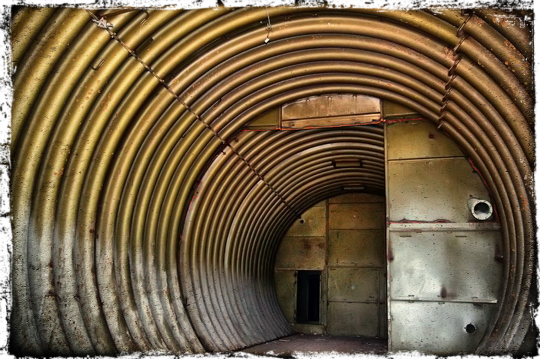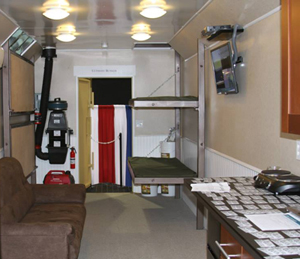
Most Preppers understand the need for an underground bunker but some may be unsure as to whether they need one or not.
Doomsday bunkers are not typically considered safe rooms that families would go to if an intruder were in the home. They can be used as storm shelters however but typically shelters of this sort are secured to a concrete slab such as in your garage or even in certain parts of your home.
Storm shelters placed underground or bolted to a concrete slab are usually designed for just a few hours of occupancy, for just a few people. They would not have an air filtration system, bathroom facilities and power would likely be battery operated. There may be room for a minimal amount of supplies. The objective of a storm shelter/safe room is to ride out the storm (usually a tornado) on the premises.
Doomsday bunkers (fallout shelter) as most people understand them today are designed to survive a nuclear, chemical or biological attack and they will protect you against marauding bands of miscreants and other criminals. However, you can only survive a nuclear attack if the bunker is properly outfitted with an air filtration system and has a power source independent of the local power grid.
A bunker of this sort would have to be designed for an extend stay so it would need among other things a water supply that cannot be contaminated and a waste facility to rid the bunker of human waste.
Is the threat to your area enough to justify the money you would need to spend? Ask yourself again, why do you need or want one and what will you need in the bunker to survive.
Buried Shipping Containers
Shipping containers are popular with many preppers and can be placed in your backyard over a weekend but ask yourself what would you use it for. The containers can be purchased for just a few thousand dollars in some cases and they can be delivered right to your home.
Keep in mind shipping containers are not designed to be buried so you will have to add additional support to prevent the top and the sides of the container from collapsing once covered with soil and/or concrete. The containers are designed to carry weight on their floor and when stacked the weight of the other containers is handled by corner supports built into the container. The actual roof itself is not designed to hold much weight or be under pressure.
One of the most cost effective ways to bury a shipping container is to use Gabion baskets to provide support for the sides, you may need to consider building some type of truss system to frame out the top of the unit as well.
The containers vary in length and there are two types. One type is designed for seagoing vessels and one is designed for domestic shipping overland. The seagoing containers are usually made of a high grade steel thus would be more expensive, while domestic containers are a combination of aluminum and steel.
Ocean going containers can be up to 40 feet while domestic ones can be 50 plus feet. Usually the smallest ones available are 20 and 45 feet respectively.
Make sure you have room for a tractor-trailer at the deliver site and have the means to off load the container if it is shipped on a flat bed trailer. If the trailer is a rollback, unloading is easy but then you have to get the container into the hole.
The containers once you have them home resemble a trailer without wheels similar to ones that would be connected to an 18-wheeler. They would make excellent storage facilities once buried. Once in the ground, you would have to treat it like any basement space and make sure you have the proper backfill along the sides for water drainage and a moisture barrier installed.
You can trench from your basement to the container and of course cover/conceal the trenches so essentially you are left with a secured tunnel/access point from your home to the container. This is done for concealment and security. You probably not want people seeing you climb into the bunker if you want the bunker kept secret.
If the bunker is not connected by, tunnels to your home this means you have to build a stairway down to the bunker from the top side and the opening has to be secured against intrusion. To protect you against radiation the bunker would have to be covered by a minimum of six feet of earth and most experts would recommend at least 10 feet.
Keep in mind if a nuclear, chemical or biological attack is your fear then you will need an air filtration system, you simply cannot take unfiltered air in from the surface if it is contaminated.
You will need air vents to the surface and then you need to disguise those vents so they cannot be found and tampered with if you have to take cover in the bunker. You can put a concrete slab over your bunker for added protection and run dummy or actual light poles up along the sides or through the slab that can be used as air vents or disguise the vents as supports for basketball hoops for example.
It would be difficult to install an air filtration system in a shipping container that would be suitable to sustain life in the event of a nuclear, biological or chemical attack. If you were within a certain radius of a nuclear blast the air you breathe would have to be filtered so the system would have to draw in air from the surface and filter it.
 Any air you receive directly from outside the bunker say 200 miles from the blast could contain radiation, and any father than 200 miles from the blast the radioactive fallout would likely be within the safe range.
Any air you receive directly from outside the bunker say 200 miles from the blast could contain radiation, and any father than 200 miles from the blast the radioactive fallout would likely be within the safe range.
An NBC (Nuclear Biological Chemical) system is what you would need. The typical system would pull the outside air into the ventilation duct then through a ULPA (Ultra Low Penetration Air) filter for example.
An ULPA filter can remove from the air at least 99.999% of dust, pollen, mold, bacteria and any airborne particles with a size of 120 nanometers (0.12 micron) or larger. This includes nuclear fallout, and biological agents.
You are not done yet however, the air will need to go through an Activated Charcoal Filter. These filters are needed to protect against many of the chemical weapons the government lists as potential homeland threats such as Nerve Agents, Vesicants (Blister Agents) and Blood/Choking Agents. You would also need a means to power a ventilation blower usually 12-volts at a minimum. You need an independent power source because the power grid will collapse.
Once again you are back to the question of why do you want a bunker. If it is to protect against air borne hazards then it is recommended that you purchase a bunker that is built for this very purpose.
 Prefabricated bunkers can come with filtration systems, lighting, bathroom facilities, sleeping areas, kitchen facilities and storage. Optional equipment for your bunker can include water tanks, generators, fuel tanks, septic tanks and a protective shield over the bunker either concrete or steel plating.
Prefabricated bunkers can come with filtration systems, lighting, bathroom facilities, sleeping areas, kitchen facilities and storage. Optional equipment for your bunker can include water tanks, generators, fuel tanks, septic tanks and a protective shield over the bunker either concrete or steel plating.
Solar energy is one option for powering your bunker along with wind turbines that have a battery backup system and then generators used as an additional backup system. Water storage tanks that can be refilled are a good option if you are not preparing for a chemical, nuclear or biological attack. If the tanks were situated above the bunker you can rely on gravity to feed the water to the bunker otherwise you would need a water pump. Keep in mind any water source above ground can be contaminated either purposely or from environmental hazards if not properly sealed and protected against tampering.
Considerations: Solar panels and wind turbines can be tampered with destroyed or simply malfunction while you are in the bunker so keep this in mind if you are installing this type of power system.
Those in the business of making and installing bunkers may have a stealth program where they attempt to keep the installation time to a minimum to limit exposure. Most of you would not want everyone in the neighborhood to know you have an underground shelter. You can tell everyone you are having a new septic tank installed or are doing repairs on the one you have.
The excavating alone will draw curious stares unless you live in a remote area. Most people assume that if there is not a foundation then there is no need for a permit. If you have to let everyone know you are putting, one in you may be defeating the purpose. You do not want everyone in the area banging on your door so to speak when the SHTF.
Shipping containers make ideal places to store your prepping supplies. You can also find protection during many natural disasters. You would however be in danger in your bunker if there is heavy flooding and wild fires in the area. The smoke would be drawn into the bunker if there were not an adequate filtration system and even if you had, one the smoke may very well overwhelm the system. Earthquakes can also damage underground bunkers.
If you have to evacuate and you have supplies stored you may be able to come back and retrieve your supplies later, as long as no one else knows they are there. If you tell every one of your plans, you may come back to an empty shell.